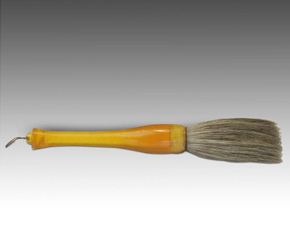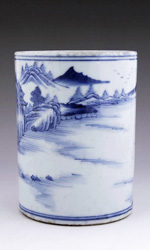The Art of Calligraphy
 |
|
The brush is the traditional writing implement in Chinese calligraphy and painting. Together with the ink stone, inkstick and paper, these four writing implements form the Four Treasures of the Study.
The body of the brush is variable, as the brush is believed to be the extension of the calligrapher’s arm. It is believed that each brush is destined to tell many stories, and develops its own personality from those stories.
 |
|
Legend has it that the Chinese written language was developed 6,000 years ago in the court of the famous Yellow Emperor when pictograms of everyday objects were developed based upon natural phenomena such as bird tracks, paw prints, and shadows from trees. The significance of this story suggests that Chinese writing was created by carefully examining what already existed rather than forging something new. In other words, to convey meaning the ancients did not write so much as read.
In the early stages of Chinese culture there were few characters, but improvements became necessary to convey more abstract ideas and concepts. This became possible by stylizing characters and combining elements to bring to mind the essence of a concept. For example, the character for “man” shows a straight back above two legs firmly planted on the ground. The character for “an official man” adds a head and shoulders and arms held firmly akimbo. Although written Chinese now calls on approximately 50,000 characters, these are derived from 214 key characters called “radicals.”
Chinese characters are essentially of fixed form, composed of an established number of brush strokes. There is a predetermined order to the writing of individual strokes, and a predetermined direction for the writing of each stroke. These rules are integral to calligraphy’s expressive dimension, for they allow later viewers to experience the original writing stroke by stroke with startling immediacy. The visual retracing of a piece of calligraphy can evoke a sense of timelessness, allowing the viewer to feel familiar with the author of a piece of writing done centuries earlier.
The Chinese historian Yang Xiong wrote, “Writing is pictures of the heart,” a reference to the expressive nature of calligraphy and the amount of practice and skill it takes to master this art form. Of all the tools needed to create calligraphy – water, ink, ink stone, paper, and brush - it is the brush which is the most difficult to master. The brush represents the point where mind, dexterity, and creative ability meet. A fully loaded, ink charged brush is difficult to wield and capable of conveying the slightest movement. Even a slight miscue may render a displeasing result or muddle a meaning.
What differentiates calligraphy as an art form from simple handwriting? The master calligrapher Wang Xi Shi likened calligraphy to a battle when he said: “The sheet of paper, a battleground; the brush, lances and swords; the ink, mind, the commander in chief; ability and dexterity, the deputies; the composition, strategy. By grasping the brush the outcome of the battle is decided. The strokes and lines are the commanders’ orders, the curves and returns are the mortal blows.” He wrote those words in the fourth century, perhaps to say it is the intention of the calligrapher that creates a work of art. If the nature of writing is to convey meaning, then the nature of calligraphy is to convey meaning in the most engaging way possible, to elevate writing to the point where it is as meaningful as the message it contains.
Download this Article: Art of Calligraphy.pdf